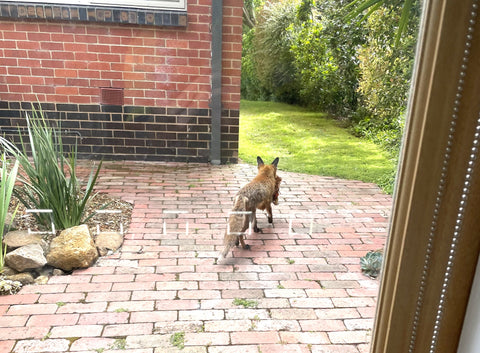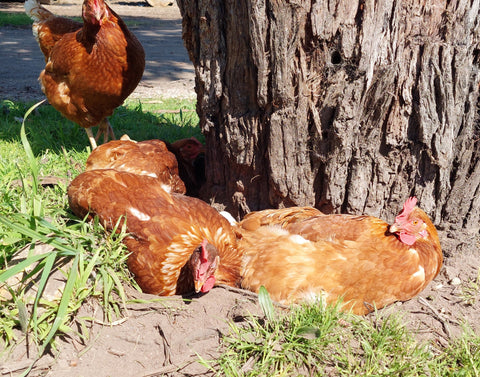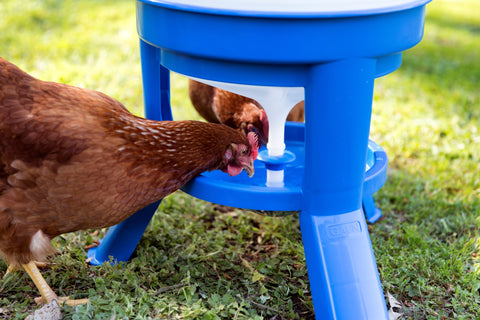Foxes are everywhere and increasingly active in urban backyards throughout Melbourne and all other cities in Australia. There is nothing more devastating to hear a commotion outside only for you to rush and find the carnage that a fox has left behind.
In this post, I wanted to provide more detail on the fox to help us better understand this predator of our happy, backyard chooks. I also wanted to provide some practical steps that urban backyard chicken keepers, such as the many families that have purchased their hens from us, can take to reduce their risks.
So let’s get started! Every week our staff hear from customers who have had their entire flock or flock members taken by foxes. These reports increase every Spring when foxes are more active and hungry.
The Red Fox: An Unwelcome Visitor to Melbourne Backyards
Origins of the Red Fox in Australia
The European red fox (Vulpes vulpes), was first introduced to Australia for hunting purposes in the 19th century. Initially brought over from Europe, red foxes were released into the wild for recreational hunting and pest control. Unfortunately, these plans backfired and the foxes quickly established themselves in the Australian landscape.
Spread of the Red Fox
The fox population has spread significantly, particularly in and around Melbourne. Their distribution covers a range of different environments, including urban areas, alpine regions, rainforests, coastal areas and the Mallee. Surprisingly, higher population densities are found in urban areas. Foxes have officially established themselves as pest animals in the state of Victoria, under the Catchment and Land Protection Act 1994.
Fox Habits and Behaviour
Foxes are primarily nocturnal hunters, with well-defined home ranges marked by territorial behaviours and social structures. Their adaptive nature and survival strategies, such as food caching (hoarding), have contributed greatly to their proliferation, posing large challenges for there management.
The Fox's Migration to Urban Melbourne
As Melbourne expanded, the red fox found itself a new niche in the city. The urban sprawl provided foxes with abundant food sources and shelter. This allowed them to thrive in this new environment. The fox has now become a common sight in Melbourne's urban areas, threatening local wildlife and our backyard chickens.
Information on the origins and characteristics of the Red Fox.
The New South Wales Government website providing insights into the impact of Foxes in urban environments.
Understanding the Fox Population in Melbourne
Estimating Fox Numbers in the City
It is estimated that there are as many as 16 foxes per km² in Melbourne, with densities higher in urban areas due to the abundance of resources such as food, water, and shelter. In contrast, in agricultural areas, fox densities are estimated to be around 4 to 8 per km². You can see why these numbers are concerning for families keeping backyard chickens.
Factors Contributing to Urban Fox Survival
There are a number of factors that contribute to the survival and proliferation of foxes in urban areas. Their mainly nocturnal hunting behaviour, well-defined home ranges marked with scents, territorial behaviours and ability to travel up to 10 to 15km per night are all key survival strategies in the city. Along with this, the availability of seasonally abundant food sources in urban areas further supports the sustainability of the red fox population.
More information on the distribution and behaviour of red foxes in Australia can be found on the Victorian Government's Agriculture website.
For a pdf sketch of the red fox with key data attached, see the Museum Victoria's factsheet
Fox Behaviour and Habits in an Urban Landscape
The Nocturnal Life of Melbourne’s Foxes
Foxes are most active during the night to avoid human interaction. Darkness provides them with the ideal conditions to search for food and establish their territory without encountering too much interference. Don’t become too complacent though as foxes are becoming increasingly brazen during the day with a lot of our customers reporting attacks.
How Foxes Establish Their Territory
Foxes in Melbourne are territorial animals, marking their territory with strong-smelling urine to communicate with other foxes in the area. By defining their boundaries, they aim to avoid unnecessary altercations and protect their resources, including food, shelter and potential mates.
The Social Structure of Foxes
The social structure of foxes revolves around family units. Vixens, or female foxes, typically establish dens in concealed locations, such as under buildings, in parks, on golf courses, or amidst foliage. Here, they raise their young, known as kits or cubs, and maintain a close-knit family unit.
Here’s more information on fox behaviour and habits in urban environments from the Parks Victoria's guide.
Living with Foxes in Melbourne: What You Can Do
Responsible Waste Management to Discourage Foxes
Proper waste management at your home is crucial in deterring foxes from urban areas. Securing rubbish bins with tight-fitting lids and avoiding overfilling them can prevent foxes from accessing food sources. It's important to securely store your chicken food along with food for your other pets. Additionally, compost bins should be secure to avoid attracting foxes with any food scraps inside.
Reporting Fox Sightings and Incidents
Reporting fox sightings and incidents is essential for monitoring fox activity in urban areas. By reporting incidents of fox harassment or predation on your chickens to your local Council or wildlife agency, you can contribute to the understanding of fox behaviour and help implement effective management strategies.
To learn more about responsible waste management practices, visit Sustainable Melbourne. Reporting fox sightings and incidents can be done through the fox scan website.
Best Deterrents for Foxes
As a chicken keeper, protecting your flock from foxes is an essential part of ensuring their safety. Foxes are intelligent and persistent predators and it’s crucial to implement effective deterrents to keep them away from your chickens. Here are some of the best methods for deterring foxes from your backyard and safeguarding your precious flock:
Secure your Chicken Coop and Run
Invest in a sturdy and secure chicken coop and run if at all possible which is the best way to provide your chickens with a safe haven from potential fox attacks. Ensure that the coop is fortified with securely attached, heavy-duty wire mesh and that there are no weak points where foxes could gain access. Regularly inspect the coop for any signs of wear and tear, and promptly repair any damage to prevent foxes from infiltrating.
Motion-Activated Lights and Alarms
Install motion-activated lights and alarms around your chicken coop to startle and deter foxes when they approach. The sudden illumination and noise will help disrupt their stealthy approach and discourage them from targeting your chickens. This extra layer of security can help to thwart potential fox attacks, especially during the night when foxes are most active. Some ultrasonic animal-repellent devices claim to provide a power deterrent to foxes and other pest animals and may be worth testing-out.
Electric Fencing
Consider installing electric poultry netting or fencing around the perimeter of your chicken coop and run if on a rural or semi-rural property. Electric fencing delivers a non-lethal yet powerful deterrent against foxes, creating a “fear-based” barrier that is difficult for them to overcome. When properly installed and maintained, electric fencing is a very effective deterrent to foxes and other predators such as Eagles and Hawks.
Predator-Proofing Your Property
Implement predator-proofing measures across your entire property to create a safer environment for your backyard chickens. This includes securing outdoor run areas, removing potential hiding spots for foxes, and keeping the surroundings well-maintained to minimise opportunities for foxes to lurk undetected.
Natural Deterrents
Foxes have a superior sense of smell when compared to dogs and most other animals. This means that it is worthwhile exploring natural deterrents such as predator-repelling plants, strong-smelling herbs, and non-toxic fox repellents to discourage foxes from approaching your chicken coop. Certain plants and odours are known to act as natural deterrents for foxes, helping to create an environment that is less appealing to these predators.
Garlic, coffee grounds and chilli powder all produce smells that help repel foxes. It is worth experimenting by creating water-based sprays using some of these ingredients and applying them to surfaces around your chicken coop and run. Male urine and hair is also despised by foxes so enlist any male family members in a strategic urination and hair donation regiment to demonstrate their love for your family flock (being mindful of dehydration on hot days!).
Talking Hens 6-Point Fox Stopping System!
In my experience, using an effective “fox stopping” system is crucial for the safety and well-being of your hens. Let's delve into a 6-point fox stopping system that is based on the previous information.
1. Secure Coop Design and Construction
Investing in a robust coop design and construction is the most important defence against foxes. Secure latches, sturdy wire mesh on all “non-board” surfaces including on the floor, and covered run area are essential.
2. Optimal Lighting Solutions
Implementing adequate lighting around the coop area can discourage foxes from approaching. Motion sensor lights or solar-powered lighting can be effective in deterring potential threats during the night.
3. Vigilant Perimeter Checks
Regularly inspecting the perimeter of your property for potential entry points is essential. Any gaps or weaknesses should be reinforced to prevent foxes from gaining easy access to the coop and run.
4. Avoiding Fox Burrowing Threats
Install, a mesh apron around the chicken coop and run perimeter or bury mesh at least 20 centimetres underground to prevent foxes from digging underneath. I like to combine this approach with a mesh floor for extra protection against tunneling rodents.
5. Implementing Scare Tactics
Utilising auditory and visual scare tactics such as predator decoys or sound devices, can deter foxes from approaching the coop. Regularly changing the position of these deterrents will enhance their effectiveness. The occasional, discrete “tinkle” by males in the family around the chicken coops, hanging breathable bags containing garlic or male hair and using spray-on formulations can also put foxes on notice.
6. Regular Monitoring and Maintenance
Consistent monitoring and maintenance of your fox stopping system is important. Regularly check the integrity of all deterrents and fortifications so that you can sleep with far greater reassurance that your flock are safe.
Remember, implementing a comprehensive fox stopping system is crucial in safeguarding your hens from potential threats. By combining these proactive measures, you can create a secure environment for your flock, promoting their safety and well-being.







Comments (1)
Can one enlist family dog for night patrol all night.